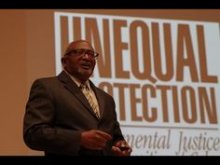Land use Environmental Issues
The design of our cities and rural communities can have great impacts on the quality of our air. Sprawl development isolates residential properties in areas far removed from employment centers and essential services. This, combined with neighborhood design that limits connectivity, typically increases dependence on the private automobile as the only means for staying connected. This vehicle dependence results in increased air emissions and long-term impacts on our air quality.
Water Pollution
Land use and land cover largely determine the type and amount of contaminants entering streams, lakes and underground waterways including aquifers. Degradation of streams banks and water quality begins with as little as ten percent impervious land cover (e.g., roads, parking lots). Therefore, land use choices and construction of impervious surfaces should be thoroughly planned with a community's water needs in mind.
Land Consumption
Human consumption of land is greater than ever. Sprawl, the low-density settlements where most Americans reside, has serious social and environmental consequences. The depletion of our most valuable natural resources has resulted in fragmented open space, loss of public spaces and a reliance on the automobile. Local planners often create artificial geographical boundaries that can work against land patterns. Zoning separates land uses and typically creates greater demand for auto access, which consumes more land than pedestrian based patterns.
Transportation Choices
The unprecedented growth in our cities and suburbs over the last 25 years has outpaced the expansion of the supporting infrastructure. The ability to expand the transportation infrastructure to meet the ever-increasing travel demands of the public continues to be a major challenge. The spatial distance between office and residential locations in the suburban community has led to increased commute times, greater air pollution, and decreased quality of life experiences.
Limited Connectivity
Many of today's neighborhoods, shopping and entertainment districts are designed to be accessible only by the automobile. This lack of pedestrian, bicycle and public transportation options leave citizens without an automobile unable to access many of their daily needs.
Weak Support for Mixed-Use Development
Zoning ordinances traditionally separate land uses preventing communities from experiencing the benefits of mixed use development. Such typical ordinances contribute to sprawl, weakened sense of community, and increased vehicular usage with associated air pollution.










